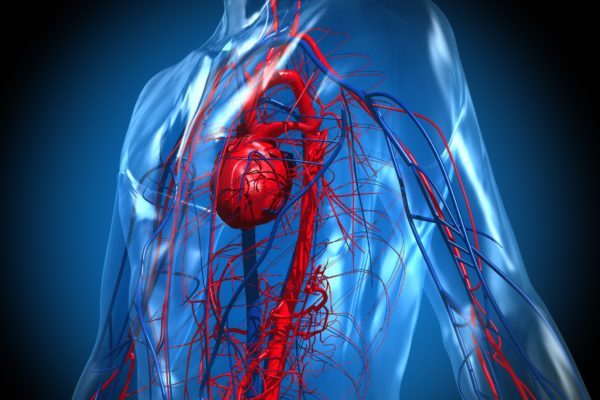Clinical picture
Sickle cell disease, or sickle cell anaemia, is an inherited and chronic (lifelong) form of anaemia. It is a group of blood disorders characterised by a malformation of the red blood cells due to the production of an aberrant type of haemoglobin, called haemoglobin S (HbS). Haemoglobin is an iron-containing protein present in red blood cells, and is responsible for the transport of oxygen from the lungs to the rest of the body and carbon dioxide back to the lungs, where the carbon dioxide is exhaled. The abnormal haemoglobin in sickle cell disease leads to red blood cells that are shaped like sickles or crescent moons, eventually leading to a disrupted oxygen transport.
Sickle cells are broken down faster than normal shaped red blood cells. Normal red blood cells have a lifespan of about 120 days; sickle cells, however, only circulate around 20 days in the bloodstream. The bone marrow is unable to produce enough new red blood cells to replace the destructed cells, resulting in a red blood cell deficiency, or anaemia.
Sickle cells are less flexible and more rigid, due to their aberrant shape, and they are unable to move easily through the blood vessels, as a result. Moreover, they tend to stick together, resulting in blockage of the blood vessels. Obstruction of the blood flow causes oxygen deficiency in organs and tissues, resulting in organ damage and intense pain. This is called sickle cell crisis. Furthermore, when an organ that fights infection such as the spleen is damaged, you become more vulnerable to infections.
How often is sickle cell disease diagnosed?
The highest incidence of sickle cell disease is found in families from Africa, South and Central America, Caribbean Islands, and countries surrounding the Mediterranean Sea. In Belgium about 1 in 1,000 newborns are born with this disease. Men and women are equally affected. The disease is present right after birth, however, the symptoms manifest after 4 to 6 months. Since January 2017, every newborn in the Netherlands is screened for sickle cell disease. In Belgium the test for sickle cell disease is not included in the newborn screening program.
With a life expectancy of 45 to 50 years, people with sickle cell disease have much shorter lives compared to the general, healthy population. This is largely due to damage to different organs such as the heart, lungs, kidneys and bones.
Symptoms
Signs of sickle cell disease usually begin in early childhood. The disease is already present at birth, however the first symptoms manifest after at least 4 months. The spleen is one of the organs that is affected first, making patients especially vulnerable to (bacterial) infections.
Symptoms can vary from person to person, the severity of which, are closely related to the anemia and the location of the obstructed blood flow. Obstruction can occur in the bones, the spleen, lungs, intestines, brain, kidneys, the penis, the eyes, causing intense pain and eventually tissue damage. Sickling of the red blood cells can be provoked by circumstances in which the need for oxygen is increased, such as:
- Fever, infections.
- Intense pain.
- Dehydration (due to vomiting, diarrhea or insufficient fluid intake).
- Intense cold (e.g. thin clothes or after swimming).
- Oxygen shortage (e.g. at high altitude).
- Heavy physical exercise, stress or exhaustion (e.g. due to exams, swimming, sports, or not enough sleep).
The most common symptoms of sickle cell disease are generally not serious.
- Fatigue, weakness and paleness due to a shortage of red blood cells.
- Fast heartbeat because the heart must pump harder to transport the reduced oxygen supply through the body.
- Jaundice (yellowish skin and eyes) due to high bilirubin levels in the blood. High bilirubin levels are a consequence of the increased break-down of the red blood cells and the degradation of hemoglobin. With this, bilirubin is released and colors the skin and the white of the eye yellow, and the urine darker.
- Stomach ache. Painful bilestones can develop due to the high bilirubin levels in the blood.
Other complication that can occur:
- Hand-foot syndrome: swollen, painful hands and feet, specifically at young age.
- Splenic sequestration. Sickle cells can block the blood vessels leading out of the spleen. When this happens, blood stays in the spleen instead of flowing through, causing the spleen to get bigger. Splenic sequestration is more common in infants and young children.
- High susceptibility to life-threatening infections such as pneumonia, meningitis, and malaria, due to splenic sequestration.
- Impaired liver function due to liver crisis or a hepatitis virus infection.
- Liver or heart failure due to iron overload (result of frequent blood transfusions).
- Ulcers (open wound) on the lower legs.
- Sickle cell crisis of the lungs (acute chest syndrome = ACS), a life-threatening condition comparable to pneumonia. ACS is caused by infection, bone crisis, or after surgery due to dysfunctional breathing.
- Pulmonary hypertension. High blood pressure in the arteries that go from the heart to the lungs due to damaged small blood vessels in the lungs. Then it is harder for blood to flow through them and the blood pressure rises.
- Strokes, due to the blockage or rupture of a blood vessel in the brain. To prevent this complication, in young children the blood flow velocity in vessels in the brain is measured.
- Silent stroke. Small, unnoticed stroke without outward symptoms associated with stroke. Occurs in 10% of young children with sickle cell disease and can result in reduced school performance.
- Ocular symptoms (sickle cell retinopathy), including eye pain, redness, decreased visual acuity. Due to blockage of the small blood vessels in the eye, depriving the eye of oxygen and causing damage to the eye. May eventually lead to blindness.
- Undesirable and painful erections. When blood does not adequately drain from the penis.
- Gallstones due to accumulation of bilirubin protein. A large proportion of sickle cell disease patients need to undergo gallbladder surgery at a very young age.
- Frequent urination. The urine concentrating ability of the kidney may be diminished as a consequence of sickle cell crisis.
- Bone complications, due to blockage of small blood vessels to the bones. Particularly the femoral head (hip) and the humeral head (shoulder) are vulnerable to damage.
- Growth recession and delayed puberty. Adults with sickle cell disease are smaller and slimmer than people without sickle cell disease.
Frequent check-ups and treatment by a physician with knowledge of sickle cell disease is desirable.
Cause
Sickle cell disease is an inherited disease. A defect (mutation) in a gene coding for the haemoglobin protein causes an aberrant form of haemoglobin, called hemoglobin S. Sickle cell disease has an autosomal recessive pattern of inheritance from the parents. The term ‘autosomal recessive’ means that both copies of the gene (from the mother and from the father) must be affected in order for the disease to be present, and that the gene is located on an autosomal chromosome (not the X or Y chromosome). Men and women run the same risk that they inherit the disease from their parents. When an individual has only one copy of the mutated gene, he or she is a carrier of the disease, also called sickle cell trait. Two parents who are each a carrier have a chance of 1 in 4 of a child with sickle cell disease.
Diagnosis
Sickle cell disease is diagnosed on the basis of presence of the disease in family members, the characteristic symptoms of the patient and laboratory tests. A differential diagnosis is used to exclude other conditions with great similarity to sickle cell disease.
In the Netherlands, every newborn is screened for sickle cell disease. In Belgium this is not (yet) the case. When there is clinical suspicion of sickle cell disease, the following tests are helpful to make the diagnosis:
- Structured patient history.
- Physical examination.
- Blood tests.
- Complete blood count. Determine nature and severity of anaemia.
- Reticulocyte (young red blood cells) count. Determine reticulocyte production index in the bone marrow. A person with sickle cell disease has a higher production index due to the increased destruction of red blood cells.
- Blood smear. Test to check on abnormally shaped red blood cells.
- Liver function tests to check on proportion of haptoglobin and bilirubin. After destruction of the red blood cells, the released iron is bound to the haptoglobin protein. Low levels of haptoglobin are an indication for increased red blood cell destruction.
- Haemoglobin electrophoresis. With this test abnormal hemoglobin is detected.
- Genetic tests for the presence of the sickle cell gene.
Additional imaging such as X-ray, magnetic resonance imaging (MRI), computed tomography (CT), Doppler ultrasound, abdominal ultrasound, and echocardiography, can take place.
Treatment
The current treatment guidelines focus on prevention, relief and treatment of the complications of the disease such as pain. People with sickle cell disease can reduce their chances of a sickle cell crisis by adopting the following lifestyle modifications:
- Drinking sufficient water, especially in warm weather.
- Wearing warm clothes in cold weather or rooms with air conditioning.
- Avoiding cold water swimming.
- Limited alcohol use.
- A healthy and varied diet.
- Sufficient sleep.
- Sufficient physical exercise. Prevent heavy physical exertion or contact sports.
- Quit smoking.
- Taking folic acid, for support of the production of new red blood cells.
Further treatment consists of limiting the amount of crises and preventing organ damage. Pain killers, additional oxygen, and fluid by infusion can be used to suppress pain during sickle cell crises.
- Alleviate pain from crises with paracetamol/codeine, NSAIDs or morphine.
- Dehydration promotes sickling of the red blood cells.
- Antibiotics and vaccinations. Patients must be vaccinated with Pneumovax against pneumonia. At least until the age of 12, children need chronic treatment with antibiotics to prevent infections. The annual influenza vaccination (flu shot) is highly recommended for all sickle cell disease patients.
- Hydroxyurea (Hydrea), a cytostatic drug that inhibits cell growth and division. This drug inhibits the production of sickle cells in the bone marrow by stimulation of the production of so called fetal haemoglobin. These red blood cells are found in children until the age of 6 months. These cells are unable to sickle. Hydroxyurea stimulates the production of these red blood cells and thereby decreases the chance of sickle cell crisis, acute chest syndrome and he amount of blood transfusions.
- Blood transfusion or exchange transfusion (erythrocytapheresis) in order to improve the oxygen transport capacity of the blood.
- Blood transfusion for patients who have signs of anemia, acute chest syndrome, a lot of crises, greatly reduced oxygen blood levels, patients who do not respons properly on hydroxyurea, or after surgery. A possible complication of blood transfusion is iron overload (too much iron in the blood).
- Exchange transfusion: at first half a liter blood is removed from the body, after which donor blood is given. This will reduce iron overload.
- Erythrocytapheresis in people with severe, recurring symptoms. The sickled cells are replaced by healthy donor cells.
- Iron chelation therapy for patients who need frequent blood transfusion. Iron overload can result in damage to the liver, liver failure, liver cancer, liver cirrhosis or heart failure. Chelators are administered via infusion (deferoxamine) or orally (deferipron or deferasirox).
- Stem cell transplantation is the only cure for sickle cell disease, but with a substantial risk of (severe) complications. Worldwide only several hundred patients received this treatment.
- Antibody-drug-conjugates
Additional information
Related articles
Links

Clinical picture

Symptoms

Cause

Diagnosis

Treatment

Patient organisations






